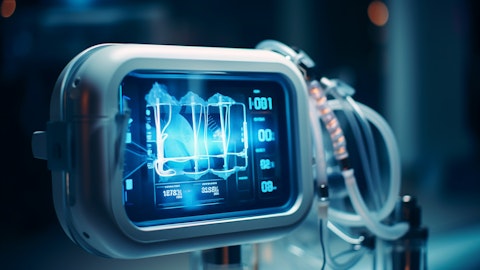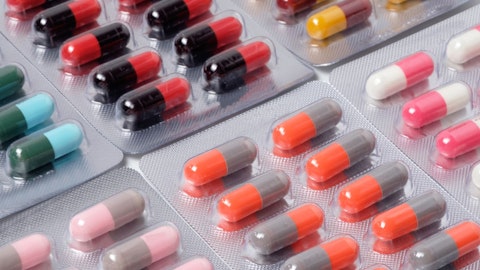Brad Welnick: The next question comes from Vijay Kumar at Evercore ISI. Vijay, please go ahead.
Vijay Kumar: Hi, guys. Thanks for taking my question. And Geoff, good morning to you. I guess one on earnings question here. I look at your peers, their earnings have grown versus fiscal ’19, 2019 pre-pandemic levels. Medtronic earnings have essentially been flattish. Can Medtronic commit to perhaps above trend earnings growth over the medium-term as you play catch-up, similar to what your peers have done? And I think related to that, Geoff, in the past, you’ve mentioned about a $400 million drag from investments in RDN, Hugo, where are we on those investments? Are they still a drag, when can those be profitable to the business?
Geoff Martha: Thanks, Vijay for the questions. I’ll start with the latter question on RDN and Hugo. And let Karen handle the earnings growth ones and further comment on RDN and Hugo. I’d say, on, look Hugo, the way we’re looking at Hugo is a part of our broader surgical franchise, an important part of that. And it needs investment. And it is, if you look at Hugo specifically, it is taking a meaningful amount of investment to keep it going here. We’ve reached — I love the milestone that we’re at now in terms of robot that’s out there that’s performing well and has got great features that are valued by physicians globally. The feedback has been strong. But we still got more work to do. We’ve got to get our instruments on there.
We’ve got to complete the US trial, we’ve got to continue to build out a US — capital equipment US sales force. So this is a tall order. But the — our confidence in executing there is high. And it’s important to this huge business, our surgical business, which is our biggest business and drives a lot of profit and cash flow. And I say our confidence is high and we’re up against a strong competitor in Intuitive. But we like our competitive positioning overall and especially against the other potential robotic companies there. And the dynamics of this market, we think you know play in our favor. So there is investment there. On RDN, by the way, we’re really trying to call Symplicity now. We got to get — we’ll get ready for some consumer education on this hypertension therapy.
So we’re trying to get rid of the RDN term as much as possible. So we got a square jar going on around here on that one. But on hypertension, this one we believe will start to show some profits here. So it’s much less of a drag, and we hope to, in the next couple of quarters, the medium-term, this to generate not just revenue, but income, it’s a highly profitable product line for us with high gross margins and it will be a positive to our overall mix. And like I said, Hugo, it’s going to take investment, but this one I think will provide oxygen, not in the next quarter or two, but over the medium-term here. So I’ll leave it there, but it’s — and turn it over to Karen.
Karen Parkhill: Yeah, and I would just say on earnings, we’ve made good progress on driving the earnings part of the company just in this year. I noted that we’ve been able to increase our guidance on the bottom line by $0.15 at the mid-point from where we initially started the year and that’s driven by the strong track-record that we’ve drove — that we’ve driven in the last — the first three quarters of this year. And we do expect that to continue. Over the medium and long term, we are committed to the right earnings growth. There’s no — there’s no debate about that. And we’re focused on overcoming the headwinds that we’ve got over that timeframe and delivering on that growth.
Ryan Weispfenning: Okay. Thanks, Vijay. We probably have time for two more questions, Brad. Take two more.
Brad Welnick: Okay. The next question goes to Matt Miksic at Barclays. Matt, please go ahead.
Matt Miksic: Hi. Thanks so much for taking the questions. Can you hear me okay?
Geoff Martha: Yeah, we can now.
Matt Miksic: Great. Thank you. So maybe just a follow-up here on some of the products that you’ve mentioned recently approved and I think some of the products that you hope to see approved in the coming quarters and I’m thinking of like Aurora and PulseSelect and maybe some additions to the US approved products in diabetes. And I know Sean mentioned sort of the rough trajectory for AF ablation. But maybe you know on that business for example, any additional color around cadence, is this something that we start to see improve in the fourth quarter or is this sort of like a early to mid ’25 kind of process and some of the same commentary for sort of cadence and trajectory in Aurora, and for example, maybe the diabetes business would be super helpful. Thanks.
Geoff Martha: Sure. So maybe I’ll start with Sean. Before I turn it over to Sean, as I pointed out in the commentary, all the puts and takes in the — our ablation business, we call, Cardiac Ablation Solutions, our AFib business, we do see an acceleration in this business and even in the fourth quarter here. So — but I’ll turn it over to Sean to talk about AFib and then Aurora.
Sean Salmon: Yeah, thanks, Geoff. And Matt the trajectory is obviously going to be upward for both the EV-ICD as well as the CAS business in total. As you launch these new technologies, there are some training that you have to do to make sure that the physicians are comfortable with how to use the products and that’s of course something we are very deliberate about to make sure that there is a good patient outcome and good acceptance of the technology. And that’s something we do pretty frequently at our business. So we’re really, really good at it. And the feedback has been excellent. The procedure efficiency on PulseSelect has been — we’re getting these cases done in like a half an hour, and the acceptance on Aurora has been exceptional too. So as I said I think it’s the same story for both of those technologies, where you push growth now but into next year will the full impact of these innovations.
Geoff Martha: Que, you want to comment on diabetes?
Que Dallara: Yeah, look, we continue to push the pipeline in diabetes. Starting with Simplera approved with CE Mark last September, followed by Simplera Sync recently approved that we announced at JPMorgan. And we completed our clinical trials for 780G with Simplera Sync in the US, which we expect to make in this first half of the calendar year. So that’s the cadence that you should expect. And as Geoff mentioned in his opening comments, we have next-generation products that we discussed at ADA last year that we continue to make progress on and aggressively moving to get next-generation tethered pumps and patch pumps out to the market.
Ryan Weispfenning: Okay. Thank you.
Geoff Martha: Thanks, Que. Thanks, Sean.
Ryan Weispfenning: Thanks, Matt. I apologize to the analysts that we weren’t able to get to. We have time now for one more, Brad.
Brad Welnick: The final question comes from Anthony Petrone at Mizuho Securities. Anthony, please go ahead.
Anthony Petrone: Thanks. Can you hear me okay?
Geoff Martha: Yeah. Anthony, we can.
Anthony Petrone: Okay, great.
Geoff Martha: Yeah, Anthony, we can hear you.
Anthony Petrone: Just on — one condolences on the passing of Tom to the team and his family. And maybe one just going to Structural Heart, maybe just to set up on SMART Study, quick two-part question. One was that ahead of schedule, was it expected to be at TCT instead of ACC. So as the late-breaker getting approved the surprise. And then maybe just high level, how do you think that study will play out once we have the results, it is head-to-head in TAVR, in high-risk symptomatic severe. So just thoughts on how you think that data is received once it’s out there, post ACC at that session in the coming weeks? Thanks.
Geoff Martha: Well, thanks. First of all, Anthony, thanks for the comment on Tom Holleran. He is a real legend around here. And just a great guy. So we’re going to miss him. On Structural Heart, two comments before I turn it over to Sean. First, I really applaud the business for their evidence generation in total. We just did our low risk data, and we publish it every year, not just when it’s convenient. And then they had the courage to do a head-to-head, which is not, you know, something that’s often done in our space. And so, I could tell you that I, for one, love that just the commitment to data and the competitiveness to go head-to-head. And I’m very much looking forward to the results, that are going to come out in early April at ACC. But in terms of the specifics of what you’re asking on how it might play out, I’ll turn that over to Sean.
Sean Salmon: Yes, thanks, Anthony. The completement of enrollment happened in October of ’22, so that’s a 12-month endpoint for the study, and that pushes you really out of the window for TCT. So, I think we’re on schedule, I’d say, we’re pleased to have been accepted as a late-breaker at ACC. But that’s really as expected I’d say. In terms of the trial itself and how it will be received, I think just right the momentum that we have on data from the notion 10-year data that’s low-risk patients out to 10 years showing superior durability of our valve compared to surgical implants, and then our four-year low-risk study with hard endpoint benefits and a widening benefit on serious outcomes like mortality and disabling stroke. And of course going head-to-head in a really important patient population, those with a small analysts.
We said that’s about 40% of the global market. Really prevalent among women and within smaller patient populations like in Japan for example. So that’s, I think it’s really important and compelling data, it’s a one year outcome which portends long-term outcomes. And I think you know we’re excited for the reception of those results. And we do think that, that’s a catalyst for growth for us with our really unique position in that particular subset of patients, which is a big chunk of the market at 40%.
Geoff Martha: Okay, thanks, Sean. And so just to wrap it up here. One final comment on the ventilation, the Monitoring and Ventilation decisions you know as a result of these portfolio decisions, Bob White will be leaving Medtronic and he has been just such an impactful and important leader for the company for a long time. And although the friendship will remain strong, we’re definitely going to miss working with him day to day, and I want to wish him — I want to wish him well. And I know that comes from the Board of Directors and the Executive Committee and everybody at Medtronic that’s interacted with Bob just a high ethical leader and just a good guy, and we wish him well. And in terms of — and so for in terms of today I just want to thank everybody for the questions.
Definitely appreciate your support and continued interest in Medtronic. And we hope you’ll join us again for our Q4 earnings broadcast, which we anticipate holding on Thursday, May 23rd. And again we’ll update you on our progress and how we finished the fiscal year, but also look ahead to fiscal ’25. So with that thanks for spending time with us today and have a great rest of your day.





